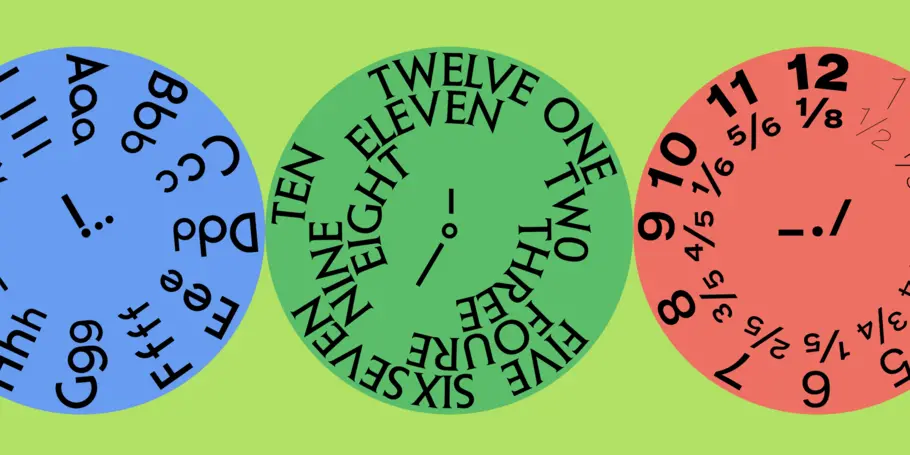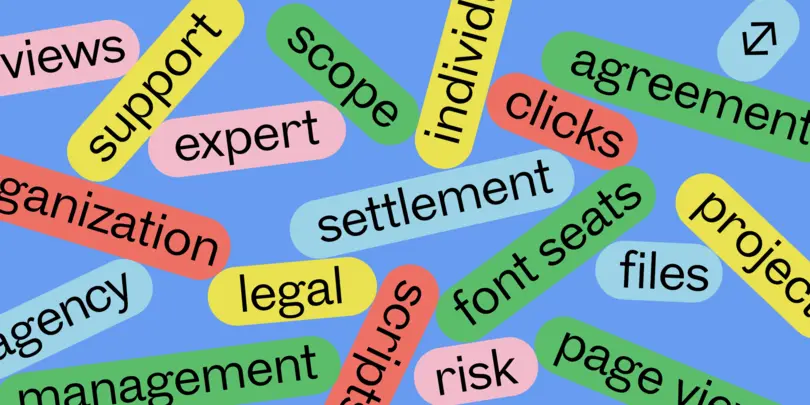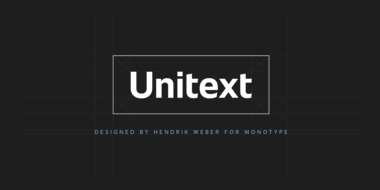Legal font licensing: Secrets to avoiding pitfalls with fonts.

Font. Music. Imagery. Colors. These elements are all integral to creating digital assets and marketing campaigns. Like Cinderella, however, only one magical font will fit a specific project or campaign. If a marketing or creative team finds what they think is the perfect font that helps express the message behind the effort, everything else seems to fall into place–except for legal font licensing.
Imagine a creative team pours hours into creating a campaign that’s engaging, optimized for multiple channels, and unique within the market. They painstakingly identify the perfect font aligned to these goals and launch the campaign.
Then, after the campaign has been released, a company’s legal team opens a letter from a font foundry stating that their successful campaign or series contains a font that has been improperly licensed. The legal team must create a plan of action and communicate constantly with the foundry, the creative team, the heads of the company, and the public relations department. The budget must now make room for a complete overhaul of the creative campaign, as well as any damages awarded to the foundry. Legal battles over font licensing make for bad press and more expenses. The campaign must be removed from both physical and digital platforms because of its lack of proper font licensing, the heads of departments must take responsibility for the error, and the company loses money.
Why even invest in a font?
Fonts are key to a good marketing campaign. Baseball teams like the Oakland As or the Washington Nationals have specific fonts that define their teams and make them stand out from other baseball teams or sports franchises. Coca-Cola has a specific font that stands out on its bright red background, while Walt Disney made a logo all on his own with a curly D. Beyond logos, fonts help brands create a clear identity with their products – think M&Ms and the Louisville Sluggers. Even from a simple campaign perspective, advertising campaigns like the ‘Got Milk?’ project used clear, easy-to-read fonts that still offered a distinctive look to the letters.
Companies who advertise or rely on different platforms must further consider fonts for each medium: some fonts might stand out on Instagram but could seem bulky and clunky on YouTube. Other fonts might translate well on a billboard but could lose a great deal of impact when they are translated to digital or mobile formatting. To have a successful advertising campaign or create a successful project for a public audience, creatives need specific fonts to help convey the necessary messages.

Foundries have it all.
Foundries, or companies that create fonts, distribute those fonts pursuant to licenses that allows users to use them in specific ways.
One major issue with licensing fonts can be the End User License Agreement, something users sign when they purchase a font or any other kind of software. Hundreds of millions of fonts exist online, and each one comes with an End User License Agreement. Legal departments can spend hundreds of hours scrutinizing each one to avoid font copyright lawsuits–and if someone misreads font licensing rules, results can be even more costly in terms of hours worked and legal settlements.
Learn from their mistakes– the problem with legal font licensing.
Designers, legal departments, and executives know firsthand the importance of crossing t’s and dotting i’s, no matter how small the print may be. Major players in industries have released marketing materials, ads, campaigns, and new brands–only to find out too late that they have used the wrong font.
What happens if you use a font without a license? In the case of companies in the entertainment industry, these mistakes can cost upwards of millions–to say nothing of the cost of labor that has to be done over again, wasted ad money, and more. Merchandise with an unlicensed or improperly licensed font has to be pulled from shelves and put in a backroom, never to see the light of day again.
Designers aren’t the only people who have to deal with this kind of headache. Depending on the level of misappropriation, a public relations nightmare begins to unfold, wreaking havoc on a company’s reputation. One company was recently accused of “font theft” in major headlines, associating the term “theft” with their brand name. Very few people intend to “steal” fonts, but the accusations often remain in the public eye or search engine results.
All these problems wouldn’t exist if the font software had been purchased, usually for significantly less than the damages incurred. One major company had to pay around $3 million in damages for a font that would have cost them only $200 or so to license.
What about free fonts?
Free fonts exist, but these free fonts come with many problems of their own. What may seem like a relatively inexpensive solution might end up costing a company more than it intended to pay. Here are just a few of the issues that arise when designers rely on free fonts:
- Similar ads or designs to competition in the industry
- Inability to scale, add special characters, or even different alphabets
- Limited creative scope
- Opportunity for malware or software viruses
- Poor font design
- Pirated fonts
While there are a handful of reliable free fonts available to users online, companies run the risk of developing ad campaigns or logos that are too similar to those in their industry, or even too similar to major players in other industries. Brands must be distinguishable for the user or customer to find them easily. Free fonts won’t give a company the individual style it deserves to help it stand out.
How long does it take to license a font?
Buying a single font can be as simple as two clicks and it’s done. But at a large or medium-sized company with larger font needs, gaining approval from all stakeholders involved can be cumbersome. If a company decides to go ahead and license a font, the process itself could take weeks or months–longer than it should to simply download a font and start using it. Legal departments must scrutinize terms of service, budget departments must approve each purchase as it comes in, and design departments must wait while other parts of the company sign off on the expense and the design itself. All that time spent waiting for approval could have been spent creating and coming up with new ideas.
If a company only needs one font at one-time, then perhaps this method would work. But if an advertising department or a creative has multiple projects going on at the same time, it would take too long to wait for approvals for each font. Furthermore, if one thing goes wrong in the assembly line of approvals, then the entire company suffers the consequences.
Solve all these licensing problems at once with a Monotype Fonts package.
For the company or individual who needs new and exciting fonts to jazz up their ad campaigns or digital assets, Monotype Fonts offers a simple solution–a package that allows access to more than 150,000 fonts. The package includes the opportunity for unlimited experimenting so you can create your masterpiece without hindrance.
This font package is a game-changer for designers, advertising executives, and small business owners as well. Furthermore, Monotype Fonts also offers the ability to resolve legal issues with misappropriated fonts–especially if the font used belongs to Monotype. Monotype will handle all legal claims and settlements when it comes to fonts, and all a company has to do is create on their own time instead of wasting hours going back and forth with legal departments, budgeting experts, and plaintiffs in court cases.
Check out Monotype’s complete library here.
Conclusion.
There is no reason to embroil creatives in all the ins and outs of finding an unlicensed font that works, or dealing with legal issues beyond the scope of their job. Monotype Fonts takes all the pressure out of finding the right presentation for a digital or physical asset for a campaign or a project.
For more information, talk to our reps at Monotype!














